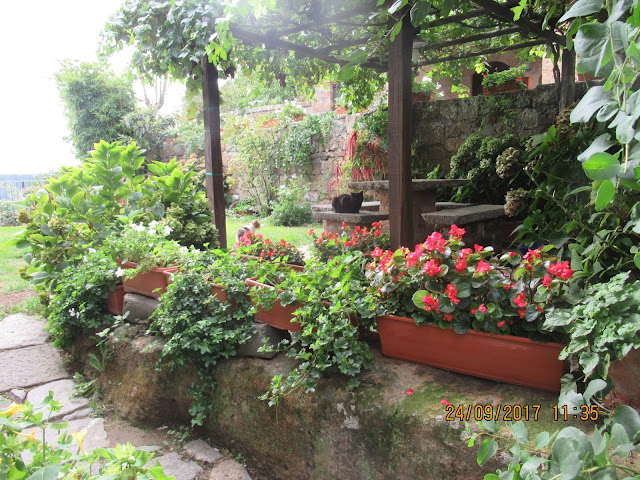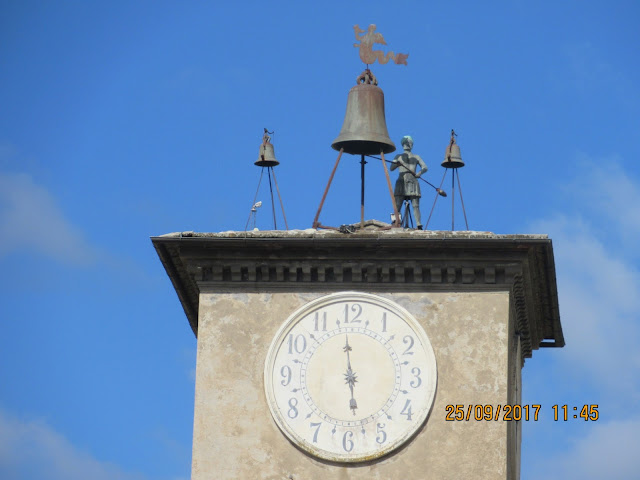While the cliff-clinging towns, winding roads and sparkling sea of the Amalfi coast are breath-taking...
While the ancient ruins, magnificent buildings, fountains and monuments of Rome and Naples are awe-inspiring...
And while the wealth of the Vatican made possible the indescribable beauty of art and creation of places like the Sistene Chapple and St. Peter's Basilica...
...THIS is the Italy that captured our imaginations and made us plan a month here, and to urge Mark and Carol to share it with us.
This is the Italy that stirs your soul and steals your heart.
We start with a stay in the hilltop Tuscany town of Monetpulciano.
We drive past this cathedral on the way to our parking spot outside of the old town:
Gianni, our Airbnb host turns over the keys then can hardly contain his love for this place he calls home as he leads us up to the piazza to look over the Tuscan landscape spread below us; then leads us down to an ancient wine cellar that still produces fine wines; and unveils in his garage two fully restored Lambretta scooters, one of which had belonged to his Nonno (grandfather).
This town is very special. Everyone is friendly and welcoming. Seniors sit by their doorways in the evening. Neighbours and family drop by for a chat and grandchildren for a hug and a kiss.
We wander into a studio and the artist brings us into his backroom, out onto the balcony where we chat in broken Italian/English, pleased when we have a mutual understanding. The building he is in is 1,500 years old. Most of the buildings in town are the same age or older.
Much of his work is done in in-laid wood and is of the buildings and nature around him.
This is the bicycle shop in town. These are electric bicycles from Barcelona, Spain that he sells. He too takes time to stop his work and have a conversation with us.
Several bicycles are for display only. This one has wooden rims, fenders & handlebars.
This bike has vital parts made of leather:
This cellar offers wine tasting
Another wine cellar. This one had an ancient, musky wine scent to it:
A view over the rooftops of Montepulciano and the Tuscan hillsides beyond:
This shop made lighting out of recycled materials.
Most took the form of musical instruments and sailing ships.
A Tuscan sunset from our balcony.
We have a car for a few days, and Mark has agreed to be the driver...yay!!
We plan a day in Siena, then on to Cortona...but don't make it past Siena. This medieval town has such interesting buildings and shops.
Like Montpulciano, in Siena drivers are encouraged to park outside of Old Town and people to walk or bus in. Fines are imposed on those who can't follow this plan.
The fan-shaped main piazza of Siena (Piazza del Campo) is enormous.
Twice every summer a horse race is held here: the Palio...and have been, since the 6th century. The rules to the race are complex and the people passionately cheer the horse and rider representing their 'contrada'.
Random photos from Siena:
Torre del Mangia, built in the 14th century. This is at the Palazzo Publico (city hall) building. Its 88-meter height is exactly the same as the cathedral ... symbolizing the church and state as having equal amounts of power.
Then we head to Civita di Bagnoregio as our new friend Sissi said we must not miss it. Civita, founded 2,500 years ago is stunning. It's like an island in the sky, or as Rick Steves says 'the jewel on a hill' and we must cross a long footbridge over a canyon to get there. Much of the city fell away in a 17th-century earthquake...and Civita became known as 'la citta che muore' (the dying city), as Bagnoregio grew and prospered.
Fall is in the air:
This bush seems to be on fire Going home we see an entire hedge of it:
Not long ago Civita could count 6 permanent residents. That number is slowly climbing in recent years as it attracts tourists.
How to get your supplies when living in Civita:
We decline to go into some underground caverns but go into a bar/cafe that has preserved an olive press that long ago was operated by a mule. There are also wooden screw presses, rope bags that the olives were gathered in plus various tools and oil storage containers. Wonderful atmosphere here.
A carving we couldn't resist:
There are many tourists in Civita today so we lunch in Bagnorecio in a lovely little back yard/garden.
We have only a couple of hours to visit Pienza, a UNESCO World Heritage site.
Moving day. Up early. Ninety-minute drive to Orvieto to return the Hertz car. Ride the funicular up to old town Orvieto. We have a couple of hours to explore before catching the train to Assisi.
The cathedral here is one of the most beautiful we've seen. The decorative work is all mosaic:
We like the weather vane atop this tower:
A two-hour train ride lands us in Assisi. We are now in Umbria.
Thankfully our Airbnb host picks us up as the train station is a bit of a distance from the old town where his place is.
We are right at the foot of a gate into the old town and on the street at the top of the climb up is a little market that supplies all of our needs. Our dinner of pasta, pesto, prawns, truffles and red wine is very satisfying.
Assisi has a beautiful Old Town. We start with the climb up to Rocca Maggiore, the old fortress.
We learn later that there is an annual medieval street festival here. The fortress has a room displaying photos from past fairs:
The armoury room:
Another tower and wall of Rocca Maggiore;
Looking along the old city wall to Rocca Minore:
We climb a narrow, steep and winding staircase to the top of the fortress for a magnificent view:
So many shapes and colours of pasta sold here. I want it all!
The cathedral:
Beautiful prosciuttos covered in red peppercorns:
Wild boar heads are in several shops and wild boar stew is delicious:
We go into a gallery (no photos allowed). The artist paints on glass ...the Umbrian landscape, beautiful skies, cypress trees and lovely poppies all beautifully framed. The pictures appear illuminated from behind. It's a stunning effect.
Sissi picks us up at 4 this day to generously show us some of this area. We stop at Santa Maria Degli Angeli on the way out of Assisi:
We also stop to see the Franciscan Sanctuary of Rivotorto at the foot of Mount Subassio. Within the sanctuary is the Sacred Hut, which was a dwelling place of St. Frances and his 'brothers' where they lived the gospel radically and in absolute poverty. It was a hovel with a roof of branches.
Sissi gifts us each with a Tau cross wooden necklace. It represents a crucifix from antiquity and also salvation.
Then we head into the beautiful little old town of Spello. Sissi explains that every year there is a Flower Festival done the entire length of the main street ... in flower petals. I had to go to the internet to see photos that people have taken of the event:
Random photos from Spello:
I am struck by this art poster. Sissi translates the words:
What pasta are you made of?
... Huh???
This is a popular expression and means 'What stuff are you made of; What's your character?"
Sissi and Simone have made reservations for us at a restaurant owned by the president of his archery club.
Fourteen-year-old Simone kindly wants to join us for dinner, so we drive to their country home. (Lorenzo, Simone's older brother is at work). This stone home seems very cozy. Sissi has a guest cottage on the property and welcomes us to return one day to stay here. We will seriously consider the offer and would be pleased to do a mix of work on the property plus some cash for rent.
The staff at the restaurant are very welcoming. They clearly are very fond of Simone. Its the first time we've seen cannelloni on a menu and we all order it. It is delicious with its delicate stuffing and mix of white and red sauces. I have a dessert of cookies that Mark and I know nonna made, but its served with a lovely sweet wine that you dip the cookies in.
The next morning Sissi picks us up early to take us to Perugia for the day. We are armed with a list of places Sissi suggests we visit, including a restaurant that serves something unique to Perugia called torta al testo (like a pizza sandwich) ... and we must eat it at Testone. OK. Done.
This is the first place in Italy where we see some street art:
Other random photos from Perugia:
Here are a gryphon and a lion. The gryphon is the symbol of the town:
Sissi picks us up at the end of the day and takes us to Lake Trasimeno. Italy's fourth-largest lake lies on the border of Tuscany and Umbria and was first settled by the Etruscans.
We could see it off in the distance from our balcony in Montepulciano. It has 3 islands with a foot ferry that can transport you there. A 50 km bicycle path encircles the lake.
Wandering a footpath by the water, chatting to local men fishing off the pier and sipping wine at a lakeside cafe is a perfect way to end a day that was in a busy city.
A sculpture in the lake:
The lovely Sissi in the middle:
Moving Day ... on to Firenze














































































































































